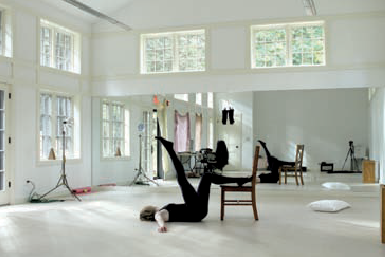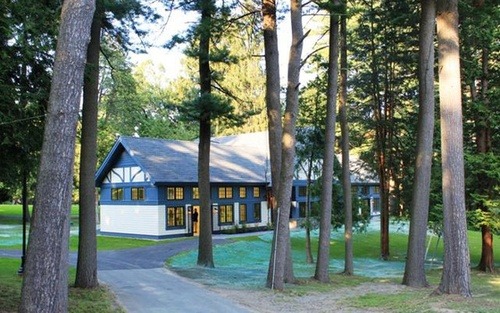
Spotlight: Residencies at Yaddo
What the residency opportunity offers, and what prospective applicants should consider before applying
Yaddo is an artist community located in Saratoga Springs, New York, that offers a year-round residency program for individual or collaborating artists working in the visual arts, music composition, performance, literature, film and video.
Residencies take place in periods that range from two to eight weeks on a 400-acre estate that accommodates up to 34 artists at a time.
NYFA talked with Lesley Leduc, Public Affairs Coordinator for Yaddo, about what the residency opportunity offers and what prospective applicants should consider before applying.
NYFA: Yaddo has welcomed thousands of artists through the decades of its rich history as an artist community. What would you say makes Yaddo uniquely different from other artist communities throughout the United States?
LL: Yaddo is unique in that it offers full room and board, and the gift of creative time, with no requirements to report on how the time is used, or to present work accomplished. The gift of time is totally unfettered.
NYFA: What should artists consider before applying to Yaddo? Can you talk about some of the residency’s benefits?
LL: Artists should be working at a professional level, should be able to work independently without guidance, instruction or supervision. It’s best if an applicant has a particular project in mind that he or she wishes to pursue during the proposed residency. The most important benefits of a residential retreat at Yaddo are protected time to create, validation as an artist, and the opportunity to interface with artists working in a variety of disciplines, from around the world.

NYFA: Yaddo offers its residency program to artists across a number of disciplines. Would you recommend to prospective applicants that they look at previous residents and their work?
LL: Yes, but just as a general guide. Artists working in new and cutting edge are most welcome to apply.
NYFA: Yaddo’s applicants are judged by the quality of their work and the professional promise of their career. What sort of criteria is used to evaluate this factor and how might an artist express this in their application?
LL: The Admissions Panels in each discipline create their own criteria for evaluation. Panelists are professional artists working at a high level in their individual disciplines, and are active participants in the art world. In general, professional promise is judged both on work already accomplished (submitted by the applicant in the work sample, and noted in the required artistic resume) and the overall aspects of the artist’s proposed project. How is professional promise measured by panelists?
NYFA: Since Yaddo can accommodate artists working in various disciplines, is there opportunity for artists to propose projects outside of their usual practice?
LL: Yes. They may also pursue an entirely new project – different than that proposed in the application – once in residence
NYFA: Residency applicants are required to submit at least two letters of recommendation. Should these references mention the applicant’s wider body of work, their proposed residency project, or both?
LL: Recommenders are asked to respond briefly to two questions – one is an evaluation of the work the applicant is currently doing, and the second is to respond to the applicant’s ability to function well in a working community of artists. The key here is brevity – with 1,500 applications a year, the Admissions Committee very much prefers a short, concise answer to these questions, rather than an extensive evaluation of the applicant’s wider body of work.
NYFA: How are work samples viewed by the admission panels?
LL: This, of course, depends on the panel. Applications in Literature are read by a minimum of two panelists independently, and then reviewed again by the full panel. Applicants in music composition, visual art, performance, and film & video are assessed first by the panelists independently, and then again by the full panel in each discipline . How should this inform an applicant’s preparation of their materials? Rather than focusing on how the admissions panels operate, it is better if applicants focus on selecting a work sample that represents their very best, recent work. The Admissions Panels are most interested in recent, consistent work, and they are interested in how the work presented relates to the proposed project.

NYFA: Though the residency offers room & board, meals, and studio access, limited financial aid is also offered to artists who have been invited to participate. Is the financial aid meant to assist artists in paying for supply costs and transportation to Yaddo?
LL: There are two funds. The Whiting Foundation supports a fund for writers (defined as writers who were approved the Admissions Panel in Literature), the grants from which may be used to support whatever expenses might be incurred as the result of a residency – in addition to transportation and supplies, these funds could be used for childcare, loss of income, rent, etc. A second fund is limited to transportation and equipment rental or supplies, and is available to artists working in the other disciplines.
NYFA: Are artists encouraged to reapply if they have already participated in the residency?
LL: Yes.
NYFA: Are there any mistakes artists should avoid when preparing and submitting their application?
LL: The biggest error artists make is in not reading the specific application and program information available on the website and in Yaddo’s online application through SlideRoom. 90 percent of the problems artists encounter in the application process could be avoided if they read the instructions and the frequently asked questions.
— Interview by David J. Bertozzi and Toccarra Holmes Thomas
For more information on Yaddo, please visit their website.
For more information about other artist residencies, visit NYFA Source and NYFA Classifieds’ Opportunities & Services for Artists.